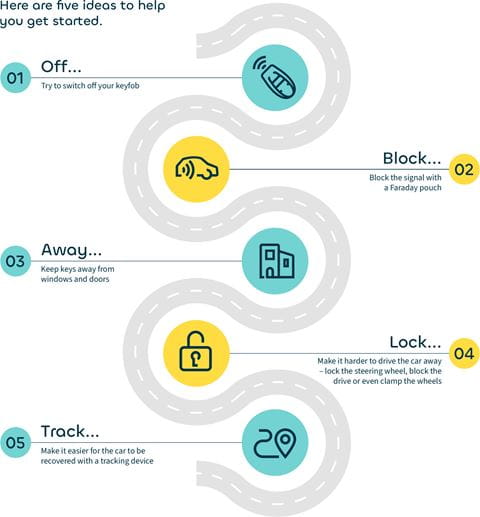
8 tips to deter keyless car theft
Keyless technology allows you to open your car door without pressing the open button on your key fob. When you put your hand on your car's door handle, the vehicle sends out a radio signal and, provided your key fob is within range, the door will open.
However, this technology can be vulnerable to hacking, with criminal gangs developing new ways to pick up the signal from a key fob inside a building and transmit it to the car - take a look how here. If you own a keyless vehicle, and you'd like a little peace of mind, here are a few tips to help keep it safe from theft.
1. Try to switch off your key fob.
Although this varies from manufacturer to manufacturer, it's possible to turn off the signal from some key fobs. The feature isn't always obvious or straightforward, but if you're going on holiday and plan on leaving the key fob at home, it could be worth checking the vehicle handbook or speak to a dealer for guidance on how to switch this functionality off.
2. Make it harder to enhance the signal.
Keyless fobs don't have a great range, so anything you can do to move them away from the car will make it harder for thieves to pick up the signal. When you've parked, try to keep the fob away from the doors and windows of your home or office. Experts suggest keeping your key fob at least five metres from the vehicle, but try leaving it further away if possible, just to be on the safe side.
3. Try to block the signal.
Instead of hanging your keys on a key hook or leaving them on the coffee table, just place them in a metal-lined Faraday pouch or box. This will block the signal from your key to your car, so thieves can't amplify it.
4. Demobilise your vehicle.
Even if you're usually careful and try to follow these tips, there are times you could make a mistake. But that doesn't mean criminals can leave with your car. If you lock the steering wheel or block your drive, you've made the vehicle harder to move. Adding wheel clamps may seem a little over the top, but it's something to consider if you're leaving your car parked in the same spot for an extended period of time.
5. Make sure your car software is up to date.
Carmakers are looking for ways to respond to this new threat - such as new frequency technologies, software and keys - so it's worth checking with your dealer occasionally to make sure that your car software is up to date.

6. Increase your chances of recovering your car.
You could consider adding a tracking device to your vehicle. If thieves do get away with it, the chances of you getting it back will significantly increase.
7. Check your insurance.
Although having the correct insurance won't stop thieves, it's important to check the wording of your policy, as some insurers haven't caught up and changed their policy wording to reflect this new technology. For example, some insurers say there must be signs of 'forcible or violent entry' for them to pay out. It's worth checking this detail with your insurance provider.
8. Remember the basics.
Finally, don't forget basic car security measures, such as parking in a well-lit, secure location and removing or hiding any valuables. Also, double-check your doors are firmly shut and that the car is locked before you walk away.
Important information:
This blog was originally published on leaseplan.com website. The views expressed may no longer be current and any reference to specific vehicles or products is for reference only. This information is not a personal recommendation for any particular vehicle, product or service - if you are unsure about the suitability of a product, you should consult with an expert.



